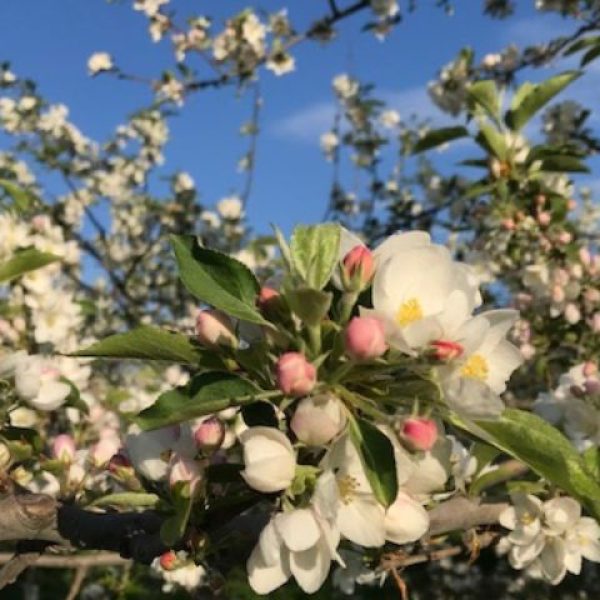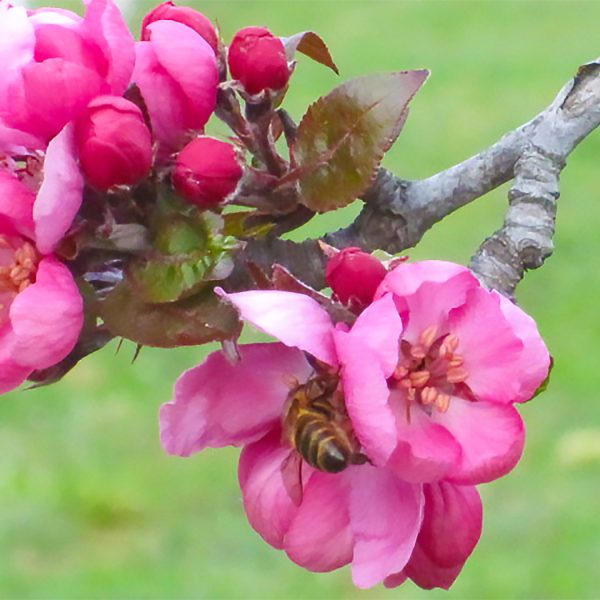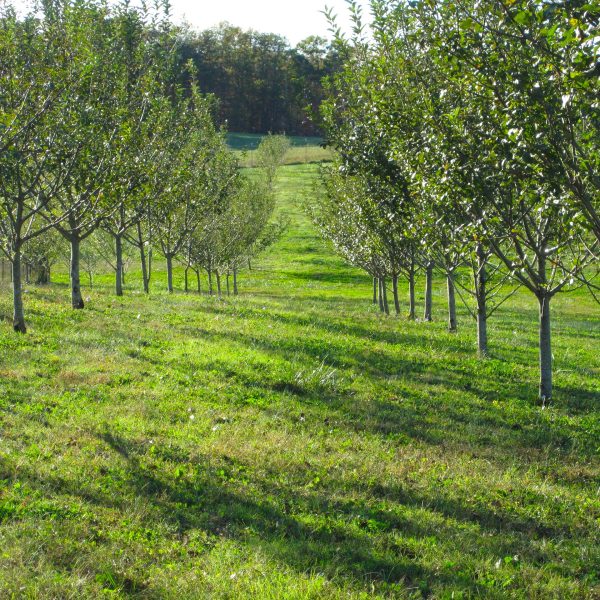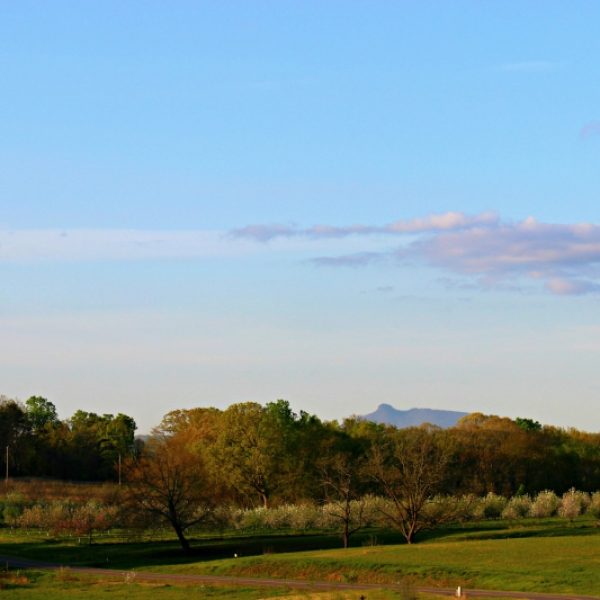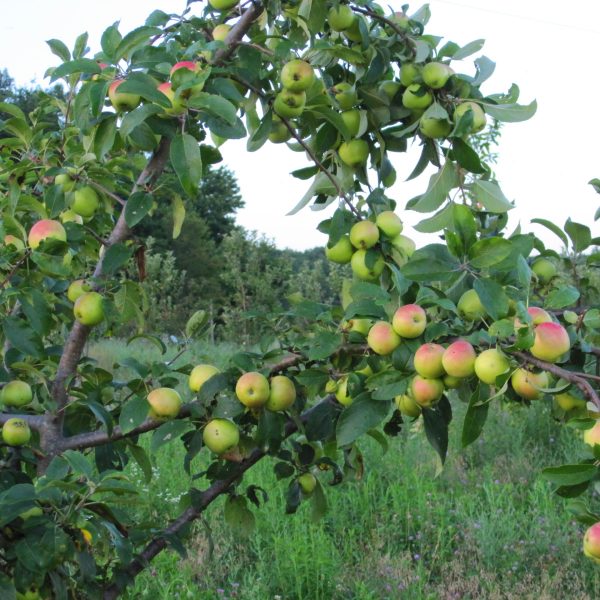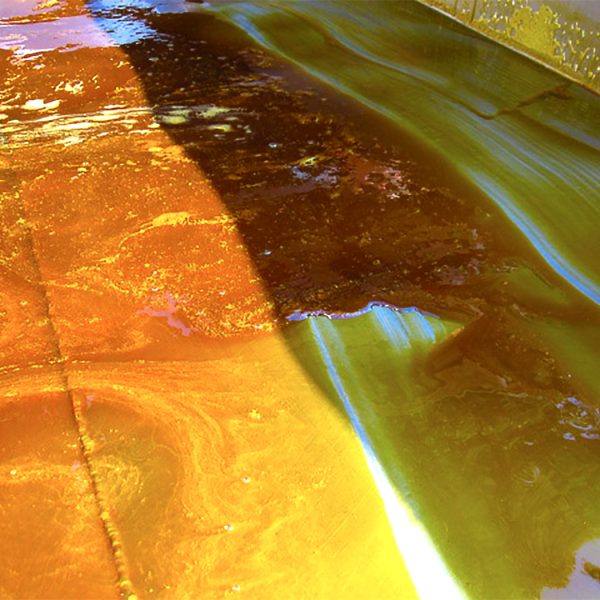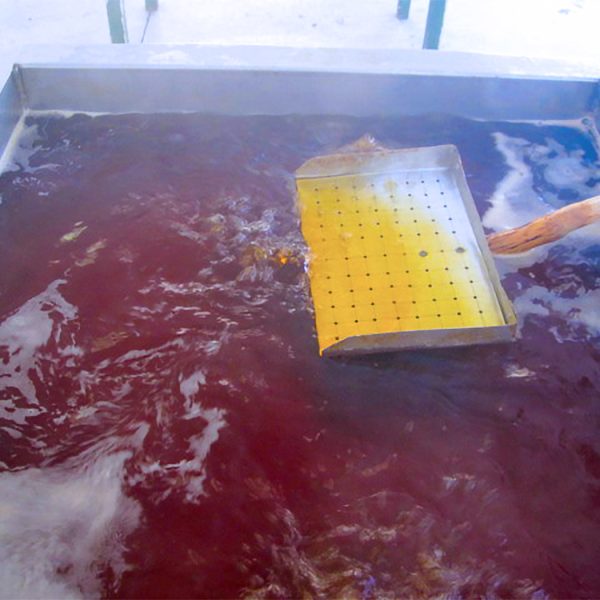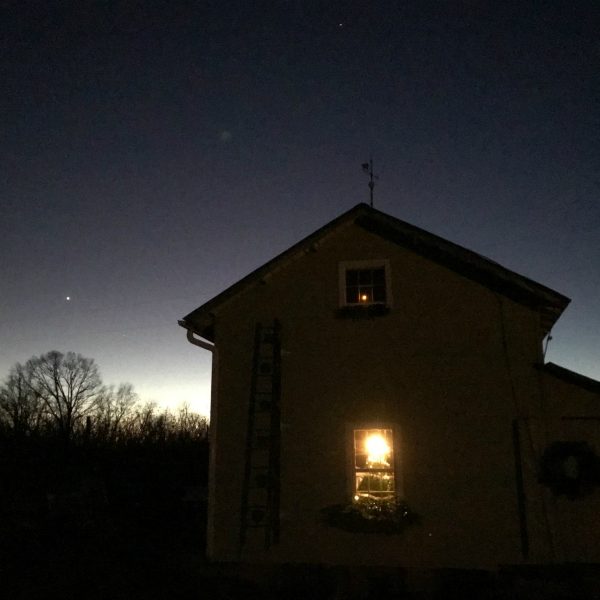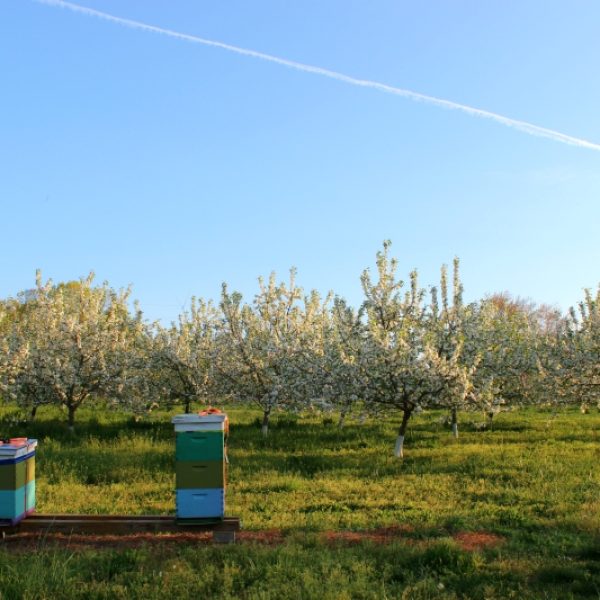Welcome to
Kordick Family Farm
Home of Baba Yaga’s Apples of Eternal Youth
History
first generation apple farmers
Kordick Family Farm is a mother-daughter operation that was founded in 2009, when we planted our first 850 apple trees in Stokes County, NC. We primarily grow heirloom, regional, and cider apple varieties, with several grafted from local sources. Sorry, you won’t find any HoneyCrisp apples on this farm. We are continually experimenting in our efforts to be as holistic as possible in practice.
At a time when most commercial orchards are moving towards high-density dwarf variety plantings of trees, our MM111 semi-dwarf trees…
…are huge by current standards, the kind of tall, sprawling trees that used to be the norm in American orchards. Growing to about 20 feet high and spaced about 16 feet apart, they require ladders to pick the fruit, but aesthetically, we just like big apple trees that you can climb in, as well as the idea that they will be here long after we’re gone. And practically-speaking, our large trees are much more hardy and self-reliant than dwarf varieties, which is always a plus in a two-person operation.
In recent years, we have expanded our apple orchard to include about 1,800 trees total, representing about 175 different apple varieties. We still graft every single apple tree we plant. We also have a small pear orchard and handfuls of other fruits, including peaches, plums, figs, che fruit, and blackberries, planted on the farm. In coming years, we will be expanding our pear planting, and are always interested in adding more tree fruits (some familiar, and some quite exotic) into the mix.
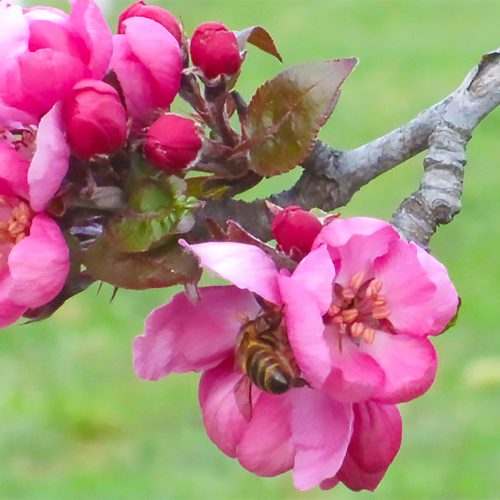
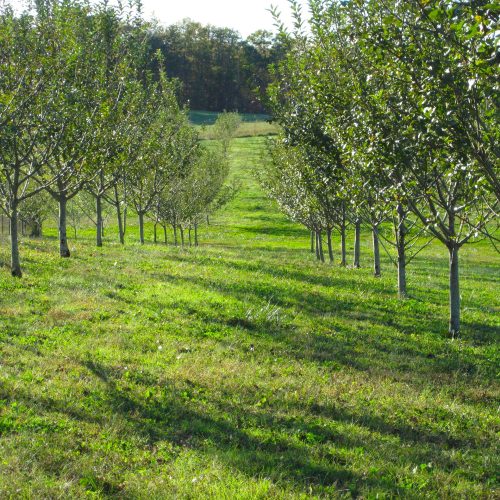
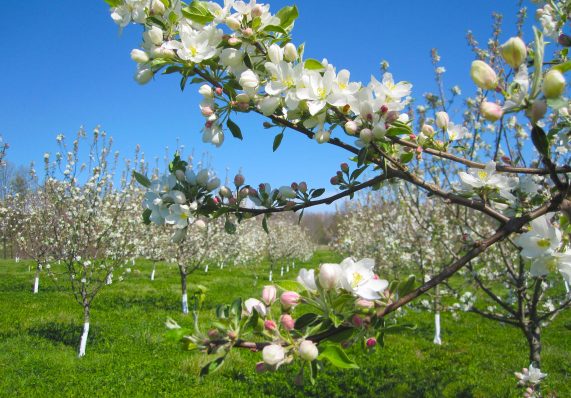

Baba Yaga
Russian Heritage
The first members of our family to emigrate from Russia to the United States came in the early 1900’s by way of Ellis Island. They settled in a Northeastern mill town and eventually started a small dairy and subsistence farm. Some of the fruit trees they planted still stand on the old homestead, and while…
…the first Kordicks in this country became proud Americans, they also left behind an appreciation for certain Old World customs and folklore that our family continues to enjoy today.
Every culture seems to have a bogeyman of sorts that is held over the heads of misbehaving children, and in Russia and several other Eastern European countries, children were raised to beware lest Baba Yaga, a rugged forest witch, seize them and gobble them up. Baba Yaga features in many famous Russian stories, often as a fearsome antagonist, yet she is also frequently portrayed as simply a wise old woman (or women, as she also may be depicted as three sisters) of the woods who serves as a guide to the heroes and heroines of folklore.
Baba Yaga
Baba Yaga's Apples of Eternal Youth story
Like many apple growers of the last century, we have deliberately branded our apples with an eye-catching logo and artwork. 20th Century fruit crate labels are now collectibles, sought after for the evocative art that was meant to catch consumers’ eyes on city streets and entice them to gravitate towards one grower’s fruits over another’s.
There is a Baba Yaga fairy tale about a quest for golden apples that bring eternal youth to those who possess them, and it was this story that inspired us to stylize our…
…apples as “Baba Yaga’s Apples of Eternal Youth,” and to come up with our own version of the story, as well as revive the old fruit crate label tradition.
We worked with Greensboro-based artist Liz McKinnon (www.heartshinestudios.com) to design a watercolor illustration of Baba Yaga with the famed apples, not in Old World Russia, but in our neck of the North Carolina foothills. As the crow flies, Kordick Family Farm is about 15 minutes north of Pilot Mountain, and we have a postcard view of the knob from the center of our property. To our west lie the Blue Ridge Mountains, while the Sauratown range borders us to the east. The Dan River is mere minutes away to the south of the farm.

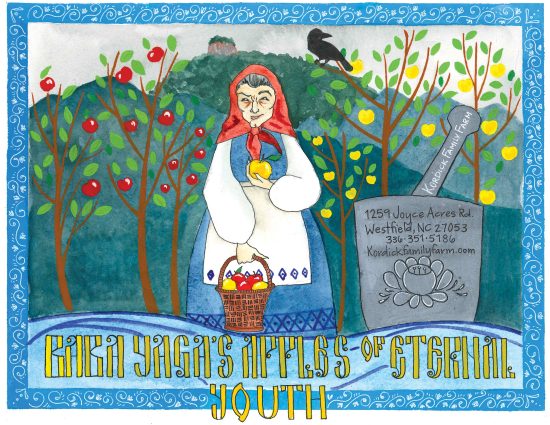
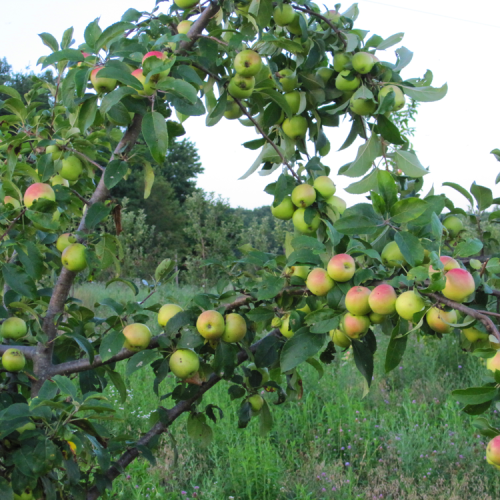
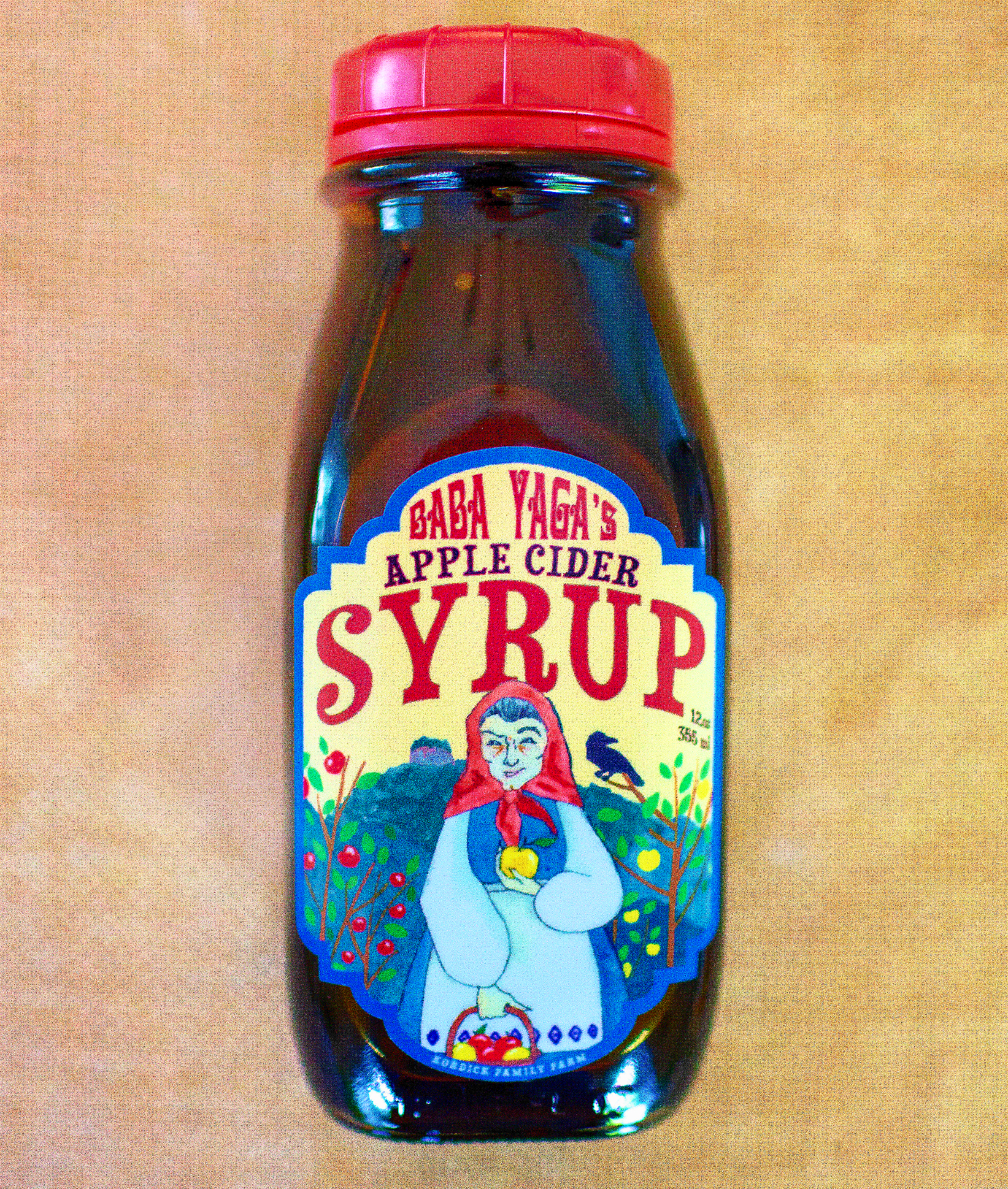
HANDMADE
Our Apple Cider Syrup
It takes a long time for large apple trees to start bearing fruit, period. And if you’re trying to grow apples in the Southeast, it takes an even longer time to hit upon the right mix of practices to produce fruit of consistently high quality. This means we’ve had a lot of time to think about what we want to do with our apples, and smaller quantities of fruit to play around with. In this manner, we created our flagship product: Baba Yaga’s Apple Cider Syrup.
Much like hard cider, apple cider syrup was …
…an American staple in past centuries, a stable, homegrown sweetener that had endless uses. However, with the advent of granulated sugar (and probably also due to the widespread razing of American apple orchards during Prohibition), cider syrup all but disappeared from the pantry.
When we became interested in re-introducing cider syrup, we sought out the local Southern experts: sorghum syrup producers. A very generous, close-knit community, our new friends taught us the sorghum syrup-making process and helped us adapt it to cider syrup.
Starting with 100% farm-pressed apple juice (cider), we boil enormous pans over a wood fire for hours until it is reduced to about 1/10 of the original volume. At this point, the sugars have concentrated to form a thickened syrup that is wonderfully fragrant and tangy in apple flavor, and is ready for . . . almost anything.
Really. It is actually easier and infinitely quicker to list the things that cider syrup wouldn’t be good on (Fish? Well, some fish. It’s actually wonderful on salmon!). The most obvious, and hard-to-beat, application is to pour cider syrup over pancakes, biscuits, and other breakfast pastries. Perhaps the most unexpected use, however, is to make a braise or sauce for savory items like pork roast or sweet potato gratin/casserole. It even pairs well with salads in the form of a vinaigrette. Try drizzling it over ice cream or yogurt, spoon it on top of oatmeal, add it to popcorn . . . Beverage-wise, you can make an instant cup of hot cider by adding about 4 Tbsp (or to taste) cider syrup to a cup of hot water. Add a shot of brandy or rum to your cup, or add cider syrup to any number of cocktails and mixed drinks. Finally, cider syrup can be used in baking, much like maple syrup.
Apple cider syrup is a staple that never should have left the American kitchen.
HOLISTIC
our growing practices
Like many unconventional farmers, we have struggled to find a term that describes our growing practices, while also communicating in a single word our management philosophy to consumers. ‘Natural’ and ‘sustainable’ mean nothing without context. ‘Low-spray’ can be used by growers who spray conventional chemicals, but at their lowest possible application rates. Most of the materials we apply happen to be approved by OMRI (the Organic Materials Review Institute), however, use of the term ‘organic’ implies certification, which we are not. We are beyond organic at this point in our growing careers, and have finally settled on the term, ‘holistic,’ in the sense championed by Michael Phillips and the Holistic Orchard Network, of which we are proud members (http://www.groworganicapples.com).
Over the years we have found the most widely available commercial formulations of organic chemicals tend to have one thing in common: it’s not so much that they work well against pests and disease and truly promote good crop health; more so, it’s that they do no harm. Low efficacy coupled with premium price tags just doesn’t cut it on our farm, and after losing apple crop after apple crop in spite of our diligent lockstep organic program, we decided we needed to find a better way to grow. We think we’ve found it. To large extent, we have stopped thinking like conventional and conventional organic growers, who are mostly concerned with preempting pest and disease pressure with preventative chemical sprays, as well as responding with curative formulations once pest and disease pressure is in evidence.
Instead, we focus on cultivating trees, and indeed, an orchard environment, of such optimal overall health that it is not as sensitive to a disease or pest outbreak, not unlike a person who eats healthy, doesn’t try to sterilize everything in sight, but maintains good hygiene, and thus is much less likely to be laid up by the latest bug going around. To that end, we nurture the root zone environment with inputs like hay and wood chips to promote a healthy fungal ecosystem that gives tree roots access to all manner of good nutrition. We also regularly apply beneficial microbes, along with fatty oils for them to feed on, to promote canopy colonization by species that work symbiotically with the tree, again to the end of excellent nutritive uptake, while also taking up space that might otherwise be “infected” by “bad” bacterial species that cause disease. And as we transition to this new way of growing, we do spray the occasional broad spectrum knockdown like copper or PerCarb, though not anywhere near as often as we did in the past, and for different purpose. Using the aforementioned chemicals as an example, when we come in and sanitize the fungal and bacterial populations with a tree spray, we don’t leave it that way and then try to maintain a sterile environment with regular subsequent sprays. What we want is to start with a clean slate for an application of beneficial microbes and to nurture this population for as long as possible. It’s all about using your tools wisely, and as it gets harder and harder to grow fruit period, we need an effective grower’s toolbox.
This is not our great-grandparents’ farmstead orchard. In the early and mid 20th Century, they simply did not have the disease and pest pressures that have spread with globalization. Also, people back then did not put quite so high a premium on fresh fruit appearance. Nowadays there are so many potential and wide-ranging issues to worry about it makes our heads spin. Unsurprisingly, the West Coast of the United States is a much more ideal environment for growing apples in general, and organic apples in particular. Plum curculio, one of the hardest pests for organic East Coast growers to control, doesn’t occur in the western half of North America, and until recently, fireblight, a devastating bacterial disease on the East Coast, wasn’t an issue either. Throwing in the endemic fungal disease smorgasbord of the humid South makes it especially tricky, to say the least, for apple growers in the Southeast who are trying to maintain a remotely organic orchard.
A lot goes into orchard management. As mentioned above, we mulch with hay whenever possible for weed suppression and cultivation of a healthy root zone. We utilize untreated trap crops and sacrifice the fruit to certain pests in the hope that it prevents them from entering the orchard proper and causing damage. We collect fallen apples and diseased prunings for burning so they don’t serve as vectors for future pest and disease development. In short, we do everything we can to reduce the need to spray — indeed, it’s a rare grower who is enthusiastic about spraying anything. Whether you’re spraying conventional or unconventional nutrients, pesticides, fungicides, herbicides, or even beneficial bacteria, it’s a time-consuming, fuel-eating, equipment-wearing hassle, and often a very expensive and potentially dangerous one. If a farmer is spraying anything, it’s because he or she truly thinks their crop and livelihood depends on it. Talk to us — most farmers would love a chance to have an honest discussion about growing practices rather than be bound by the are-you-organic-or-not litmus test.
Organic chemicals and materials can be abused as much as conventional ones, can be just as bad for pollinators, and can also accumulate to the detriment of the environment. In addition, decreased efficacy often means increased application. You can go out of your way to avoid synthetic chemicals derived from fossil fuels, but if you have to spend more time on your tractor burning fuel and compacting the soil in order to apply them, is that sustainable? Rather than lecture you on our definition of sustainability, we will keep an updated list on this website of what we spray and why, as well as this discussion of practices, as it evolves, and you can decide for yourself if this meets your definition of sustainability.
We maintain mason bee houses in the orchard, as well as honeybees and pastured rabbits. If we wear any safety clothing/masks while spraying, it’s generally to keep from getting soaked and filthy. We don’t spray anything that we consider unsafe to our bees, livestock, or ourselves.
Oxidate 5.0: an OMRI-listed hydrogen peroxide that kills bacteria and fungi. We use this in the early spring pre-bloom as a broad knock-down to help create a blank slate for our subsequent beneficial bacteria applications.
Nordox WP: an OMRI-listed slow-release copper formulation that kills bacteria and fungi, and also helps prevent frost molecules from forming. Sometimes applied in the spring pre-bloom to give us some protection when the trees are most vulnerable to infections and frost damage.
AgriPhage: OMRI-listed, contains bacteriophages that specifically target the bacterium responsible for fireblight. After several years of steadily increasing fireblight pressure in the orchard, we have finally found a biological product that can make even the worst shoot blight take a seat on the bus like everybody else.
Core Holistic Spray: a rotating cocktail applied ten or more times a growing season for nutrition and disease/pest prevention, including some or all of the following — Ahimsa pure neem oil (OMRI-listed)*, Ahimsa karanja oil (OMRI-listed), EM-1 beneficial microbes (OMRI-listed, and brewed on-farm from a mother culture), SeaCrop sea minerals (OMRI-listed), AEA Micropak trace minerals (OMRI-listed), Charley’s Soap (a locally-made, environmentally-friendly soap that we use to help emulsify the brew components)
Xentari Bt: an OMRI-listed, specifically honeybee-friendly, Bt, or Bacillus thuringiensis, that attacks certain insect larvae
Isomate mating disruptors: OMRI-listed dispensers that are hung from tree canopies to release mating pheromones of Oriental fruit moth and codling moth to make it harder for adults to find each other and reproduce within the orchard.
Quantum Light: a supplement to our EM-1 beneficial microbes, which are primarily composed of lactic acid bacteria. Quantum Light contains “the purple guys,” varieties of photosynthetic bacteria, which colonize apple leaves when applied, and help make nutrients available for the trees specifically via photosynthesis.
Lime Sulfur: OMRI-listed, but our least favorite thing in the world to spray! It is very caustic and can cause severe corrosion on equipment and our persons (burns), but it is very useful when severe broad-spectrum disease clean-up is needed in the orchard. Can also be used as to thin blossoms during bloomtime, but of course, it also kills beneficial fungi and bacteria. For that reason, it is often used pre-beneficial biological applications to create a blank slate to start from.
Blossom Protect/Buffer Protect: OMRI-listed strains of Aureobasidium pullulans that provide protection against early season fireblight by colonizing blossoms in a prophylactic manner and creating an inhospitable environment for fireblight-causing bacteria by acidifying the blossom interior.
Lalstop G46: OMRI-listed Gliocladium catenulatum, a naturally occurring, saprophytic fungus that thrives in cool climates (or very early spring in the South) and provides an early season protective barrier against pathogens (we’re specifically targeting fungal rots like Colletotrichum), and parasitizes them, to boot.
Howler: an OMRI-listed Pseudomonas chlororaphis formulation that provides preventative control against fruit rot pathogens via several modes of action.
Grandevo: OMRI-listed formulation of Chromobacterium subtsugae strain and spent fermentation media that afflicts our archnemesis, plum curculio, as a stomach poison.
*In 2022, we will switch from using Ahimsa pure neem oil in our core holistic spray to TerraMerra’s TerraNeem, an OMRI-listed 85% neem formulation with significantly higher azadirachtin, the chemical compound found in neem oil that is responsible for its insecticidal properties. After a particularly bad aphid year in 2020, we feel the need to beef up our core holistic spray a notch, while still providing most of the fatty acids that support our EM-1 beneficial bacteria
Got questions or concerns? Check out our contact info further down on this page and drop us a line.
Ah, April, when the early apple trees enter petal fall stage, fruitlets begin to develop . . . and plum curculio (Conotrachelus nenuphar) rears its ugly, little head. Plum curculio may be tiny, usually only a quarter of an inch or less in length, but it causes bigtime damage in Eastern fruit orchards every year. There are many growers who are organic in every way, save the exceptions they make to combat plum curculio. A hard-bodied, extremely tenacious weevil, its modus operandi is to overwinter in the woods surrounding orchards, then move into the orchard proper at petal fall with the goal of laying as many eggs as possible in developing fruits.
The larvae develop inside the fruitlets, causing damage one of two ways: 1) the larvae fully develop, secreting certain chemicals that make the fruitlet drop to the ground, where the grown larvae can penetrate the soil to complete the life cycle, or 2) the larvae may be crushed to death as the young fruitlet grows rapidly, leaving the initial damage from the egg deposit as a gateway for other pests and diseases. Either way, they are a major, major headache that growers have been battling for a century or more. There are neat photographs of early twentieth century growers out with large teams, literally beating the trees to shake the curculio adults onto sheets spread below the trees, to be removed from the orchard for certain destruction.
The key to controlling plum curculio is stopping the population cycle — you want to reduce the number of egg-laying adults that you will have to combat the next year, so most of the time, you’re actually targeting the larvae themselves in a number of ways.
We have planted trap crops of early-fruiting plum and peach trees so we can sacrifice the fruit to the plum curculio and target the larvae before they move into the later-fruiting apples. Sound theory, but it doesn’t always work so well since, in this area, cold springs often preclude peach, and especially plum, fruitset. So most of the plum curculio probably make it past the trap crop in any given year to the orchard proper.
The next line of defense is to apply coats of refined kaolin clay to your trees. The clay particles slough off onto curculios making their way into the trees, getting into all their orifices and irritating them. The idea is to convince them that our apple trees are just not worth the pain and suffering. But in order to be effective, kaolin clay has to be applied in a heavy and consistent enough layer, easier said than done around bloomtime, when growers are busiest and the weather is rainiest (the clay will wash off in rain, so many layers are required).
So historically, many adults do succeed in their raison d’etre, to deposit their eggs under the skin of our new apples. But we still need to target the larvae in order to prevent a larger repeat of this whole cycle the next year. One thing we are experimenting with this year is to apply parasitic nematodes to the soil beneath trees, where they will happily gobble up plum curculio larvae after they penetrate the soil.
We only have a few apple varieties at the petal fall stage right now, but in the last two days, have casually stumbled upon two plum curculio adults in the central orchard. Scary stuff, indicative of a very large population that is up on its game. This year we will also be applying Venerate, an OMRI-approved formulation of heat-killed bacteria, which secrete natural, exoskeleton-targeting toxins that interrupt the plum curculios’ molting process, leading to death. We’ll have to wait out the rain for the next three days, and keep our fingers crossed that we’re not too late.


CURRENT EVENTS

Spring Work: Toto, I don’t think we’re in winter anymore . . . The orchard woke up earlier than ever this year and the trend has continued. We pivoted harder than usual from pruning right into our spring sprays, pest monitoring, understory management, mulching, etc. Now that we’re past bloom and fruitset, we’re taking a minute to get our spring grafting before temperatures skyrocket.
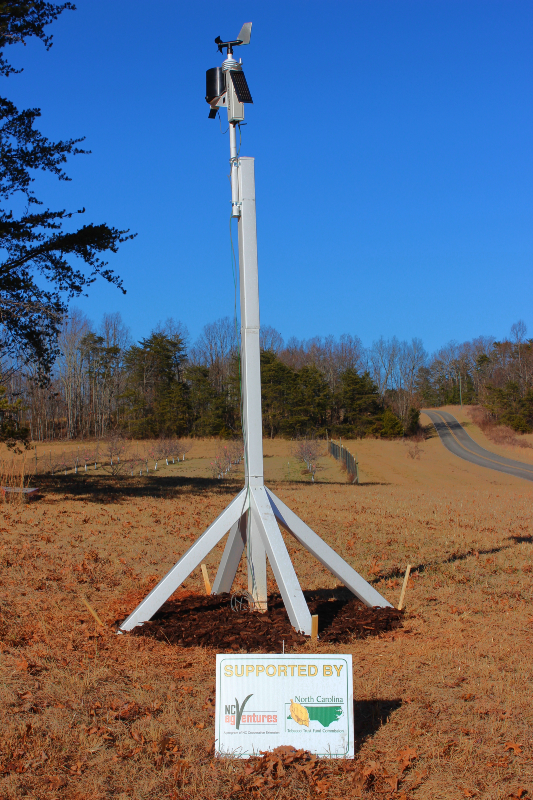
CHECK OUT OUR WEATHER STATION!
Thanks in large part to an NC AgVentures grant, we installed a RainWise weather station at the orchard in winter 2021. Having such site-specific weather data at our fingertips will help us make better management decisions. And since our information is public, local gardeners and growers can also benefit.
Check out our current weather conditions via our RainWiseNet webpage!
Check out our local pest and disease forecasts via our NEWA (Network for Environmental and Weather Applications) webpage! (Select “Westfield” from the drop-down weather station list.)
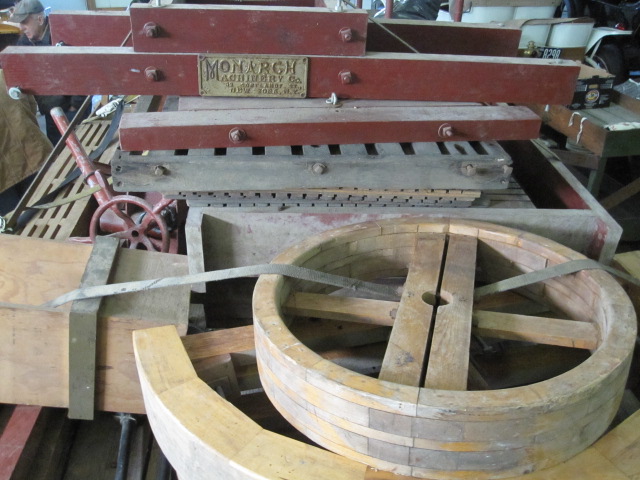
This pile of stuff was once an enormous 100 year-old cider press, and soon it will be again . . . when we find the time and space to get it up and running again. Stay tuned. For now, it’s a sight to see, with all its fascinating nuts and bolts (and massive pulleys) on display in the orchard packhouse.




Petalfall, ho! The apple blossoms were beautiful and prolonged this year, but the recent warm temperatures and high winds have brought primary bloom to an end . . . with some notable exceptions, like ‘Dabinett’ (see the featured apple of the month profile below). Aside from a handful of late bloomers, the only flowers we will see from here on out will be so-called “rat-tail” blooms that linger out of season here and there. As you can see pictured above, our ‘Redfield’ trees, some of our earliest bloomers, are well past petalfall and into the fruit sizing window. Still, we can find a smattering of blossoms and buds out there, although it’s pretty unusual to see a new flower open up so much later from the same cluster where a fruitlet is already growing.
Apple growers refer to these bothersome late blossoms as rat-tails because the stems of the flowers tend to be particularly skinny and elongated. They are considered bothersome because these late flowers are more likely to become infected by pathogens when they bloom in warmer weather, potentially triggering a disease cycle in an otherwise healthy tree. Also, if rat-tail bloom occurs completely out of season in late summer or fall, it can affect return bloom the following season. Thus, if we experience rat-tail blooms budding up in August or September, we try to snip them out if we have time.
We’re creeping ever closer to our last freeze date and are happy to say it’s looking good for our apple crop! While we’re very busy taking care of it, now it’s also time for us to start grafting new trees. This year, we have some special scionwood to play with. Earlier in the year, we obtained wood from several varieties of Spanish cider apples from the USDA apple germplasm repository in Geneva, New York. This is where genetic material from outside the United States comes upon arrival for years of quarantine and trialing, before being released to growers and researchers for use in the field.
Spain provided a number of their best-known hard cider and dessert varieties to the repository about 20 years ago, and they are finally starting to make their way into the hands of growers like us. We are interested in trialing these warmer climate apples in our orchard to see if they do better than others in the hot, humid Southeast. With evocative names like ‘Piel del Sapo,’ or “Skin of the Toad” and ‘Sangre de Toro,’ or “Blood of the Bull,” these varieties sound so exotic to our North Carolina ears.
If you’re into hard cider, you may be hearing more about Spanish ciders. Americans are increasingly widening their palates to include the sort of sour, wild-fermented ciders that the Asturias region of Spain, in particular, is known for, and it’s becoming easier to find stateside, as are Spanish-style sour ciders made by American cideries. For those of you who may not know, Spanish cider culture is pretty unique and fun.
Traditionally, the cider, or sidra, produced there is flat, rather than sparkling, but effervescence is produced to order with a flamboyant, daredevil pour from a cider bottle in one hand, held high over the pourer’s head, splashing into a glass cupped in the other hand stretched below the waist. These “culetes,” or small draughts of sidra, are meant to be drunk at once, like a shot of liquor. Spanish bars, or sidreries, that serve sidra in this fashion often rely upon sawdust littered floors to soak up the inevitable over-rim splashes. And here’s a fun fact: in 2022 Gijon, a municipality in Asturias, again broke the world record for the most people simultaneously pouring cider at once — 9,796, to be exact. This is something of a tradition as most previous world records in this category were also set by Gijon, but in any case, ¡salud! to Gijon!
In recent years, the regulations governing Asturias sidra have loosened a bit, but only relatively speaking. Now, rather than restricting producers to 22 Spanish cider apple varieties, 76 are acceptable for sidra labelled as “Sidra de Asturias.” Producers have also been allowed to move beyond the so-called flat “sidra natural” made via wild fermentation into “Sidra Natural de Nueva Expresion,” basically sidra natural that has been filtered and stabilized, as well as “Natural Sparkling Cider,” a sparkling brut version.
Spain is actually the fourth largest producer of cider in Europe, behind England, Ireland and France. While the humid, cooler Atlantic coastline is challenging for grape-growing, apples do well in this climate, as well as the mineral-rich soils that tend toward the acidic side. Our Southeastern climate is definitely warmer on average than Asturias, but we are so excited about the 8 Spanish cider varieties we’re grafting, we are uncharacteristically grafting much of the scionwood onto dwarf rootstock so we can sample the fruit that much sooner. It will still be a few years before we have enough fruit to do much with, but in the meantime, we can practice our sidra pouring technique!
May is just around the corner and, while the fruitlets are already sizing up on most of the trees in our orchard, we are still waiting on our absolute latest variety to fully emerge from dormancy and begin blooming . . . next month! We have a single Dabinett tree growing in our test orchard and it is far and away our latest variety, although we’ve only just come to understand why this is the case.
Last month we decided to feature Dabinett for April as the perfect coda to our March newsletter’s emphasis on bloomtime. The variety is a well-known English cider apple and, as a full bittersweet that makes high quality single varietal ciders, it is being planted in more and more American orchards. As we researched the variety’s history, we found an article explaining why Dabinett is gaining a reputation for late annual emergence and sluggish growth habit. Always small, finicky, and only moderately vigorous, apparently, this variety benefits from more chill hours (temperatures below 30 degrees F) over the winter than we can provide in our climate. If it does not receive them, Dabinett is notorious for waking up later than its already late tendency and grows pretty pitifully as it struggles to catch up.
We can attest to this, and it’s one reason why we have stuck with just the one tree in our test orchard thus far, although we’d love to be able to produce decent quantities of Dabinett fruit far beyond the literal handful of apples we’ve been able to harvest from our one tree over the years. Sidenote, we have mentioned our test orchard before, but we’re not sure if we’ve ever explained what it is for folks who may not be in the know. It is very common practice for commercial orchardists just getting started with unusual or heirloom varieties to plant a small pilot orchard to test which varieties will do well at the orchard location. After some years of observation, the orchardist can make better-informed decisions about which varieties will do well enough to justify larger scale plantings.
In this case, planting Dabinett in our test orchard before investing in a larger block really paid off, as we have found that it does not do great for us here. Perhaps we may eventually plant a small block in a severe cold pocket where none of our other varieties would stand a chance, given their normal blooming tendencies, but for now, we’ve abandoned any delusions of Dabinett grandeur. But now that we know of Dabinett’s chill hour proclivities, we may try to manipulate our pathetically small young trees into more pronounced early growth by keeping them potted and in our walk-in cooler over next winter to provide more chill hours.
After all, Dabinett ain’t from around here, anyway. The variety hails from the small village of Middle Lambrook in Somerset, where it started life as a ‘gribble’ in Old English-speak, an apple tree that was self-sown and grew up wild. It was discovered in a hedge by a villager named William Dabinett in the late 1800s. We don’t know much else about its earliest beginnings, how it migrated from that hedge to the orchard, but by at least 1895 it was already being used in cider.
Indeed, much like the analytical chemistry surveys of cider apples conducted today in order to guide producers, there was a local effort in this corner of rural England to improve their ciders. Accordingly, a chemist was hired, fruit was picked from a Dabinett tree, as well as others, and the juice analyzed, with the results published in 1896. As a continuation of this cider improvement effort, a cider competition was inaugurated, and in the 1897 outing, surprise, a Dabinett blend was a prizewinner!
While Dabinett become quite popular in its home range in subsequent years, the National Fruit and Cider Institute that was established in 1903 had taken notice of the fruit, as well, and cultivated it in their research orchard for further field and cider testing. Ultimately, it was the NFCI that championed Dabinett as one of the best English cider varieties with regards to quality and profitability.
Given its reputation as one of the finest cider fruits, Dabinett eventually expanded its range within England throughout the 20th Century, and from there, conquered the world, at least, in terms of the niche that is the hard cider world. It finally came to the United States in 1985 as an accession by way of our friends at the USDA germplasm repository. Traditionally, the parentage of Dabinett was held to include ‘Chisel Jersey,’ another of Somerset’s gifts to the cider world, but recent DNA analysis doesn’t support that history.
Similar to Chisel Jersey, however, Dabinett’s flavor is sweet, rather than acidic, but highly astringent. A wise person drinks Dabinett apples, rather than attempt to enjoy them fresh. Likewise, cooking won’t do this apple any favors either, and generally just serves to exacerbate the variety’s already dry, tough flesh. Oh, and don’t bother growing this apple for its looks, as it is pretty unremarkably dull red over yellow, and small to medium fruit to boot. But who needs appearance and fresh flavor when a pressing of Dabinett apples produces such fine drink. The cider is gorgeously gold in color and can be relied upon for good balance, full body, ample flavor, and dry finish. The typically high brix, or degree of sweetness, makes for ciders with hefty ABV numbers. It can work as a single varietal, but these attributes also make Dabinett a particularly great apple to include in blends.
We like to think of Dabinett as a worthwhile challenge, by no means to be relied on in our orchard, but worth experimenting with as a hobby. Who knows — perhaps 50 years from now our wee Dabinett trees will have caught up to the rest of the orchard and be producing as if they never skipped, er, several beats. Or maybe we’ll use the variety to try and breed some really late-blooming cider cultivars that do like it here. We’re trying to justify it, but really, if you’re interested in hard cider, a Dabinett tree is just something you want to have by your side, for cultural and historical interest, if nothing else.
Apples with pork is one of those classic combinations guaranteed to make the mouth water. Spiked with lime juice and packaged in a flaky empanada crust Spanish-style takes it to another level. We wouldn’t call it apple pie season yet, but with fruitset and the last potential freeze date around the corner we’re inching that much closer, so it feels appropriate to celebrate with some apple-y handpies. We adapted this recipe from an original at unclejerryskitchen.com and used jackfruit to make a truly mouthwatering vegetarian version.
1 batch empanada dough (recipe below) or 1 pkg. 10 count empanada rounds, defrosted
Empanada dough:
2 cups flour (plus flour for rolling out dough)
½ cup shortening, chilled
2 ½ Tbsp. butter, in bits, chilled
½ tsp. salt
Approximately 5 Tbsp. ice water
Filling:
2 (14 ounce) cans young jackfruit, rinsed, drained and shredded (or substitute 1 lb. leftover shredded roast pork)
3 Tbsp. butter
2 medium Granny Smith apples, finely diced, divided
½ – ¾ cup vegetable stock
1 Tbsp. cinnamon
1 ½ tsp. chili powder
2 tsp. ground cumin
1 Tbsp. onion powder
3 cloves minced garlic
2 Tbsp dried cilantro leaves
Salt and coarsely ground pepper for seasoning and garnish
Juice from 1 lime
1 egg, beaten with 1 Tbsp. water for glaze
Lime wedges for serving
If you are making your own empanada dough, prepare it first (or even the day before) so it can chill while the filling is cooking.
Combine shortening, butter, flour, and salt in medium bowl. Cut fats into dry ingredients until well mixed and like pea-sized pieces. Stir in water, 1 Tbsp. at a time and toss with fork until dough forms. Knead lightly until it stays in a ball. Place in covered bowl and chill at least 1 hour or overnight.
To make the filling, place half of the apples and 2 Tbsp. butter in a 3 qt. saucepan over medium heat. Cook, stirring frequently until apples are slightly softened. Add cinnamon, chili powder, cumin, onion powder, garlic, and cilantro leaves. Cook, stirring for about 1 minute. Add jackfruit (or pork), 1 Tbsp. butter and ½ cup stock. Stir to combine and bring to a simmer. Cover and simmer approximately 15 minutes, stirring occasionally. Add more stock, if needed, to prevent sticking.
Taste and adjust seasoning with salt and pepper. Stir in the rest of the diced apples and the juice of 1 lime. Set aside to cool.
Line baking sheet with parchment paper. Set it aside. Roll dough on floured surface to 1/8 inch thickness. Cut into 4 inch rounds. Moisten edges of dough with some egg glaze. Place a 2 Tbsp. of filling in center of round then fold dough over to enclose the filling. Seal edges with tines of a fork and place on baking sheet. Reroll scraps of dough until it is used up.
Brush empanadas with egg glaze and sprinkle with a generous amount of black pepper. Bake at 350F until golden, about 30 minutes. Serve warm or cold with wedges of lime.
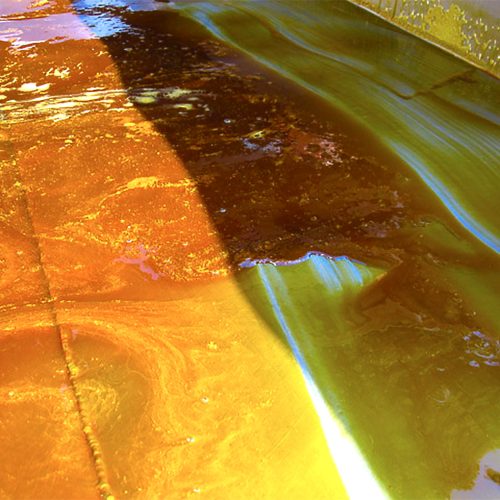
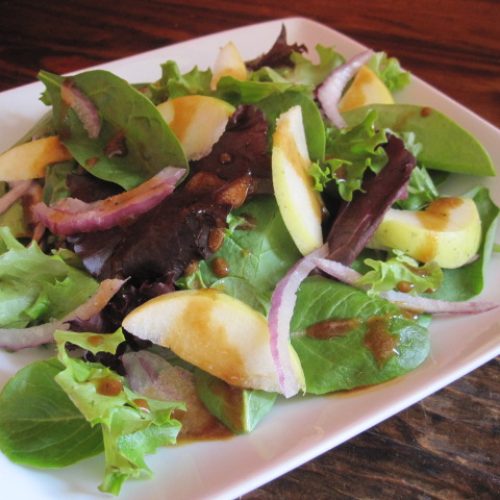
Cider Syrup
Recipes
Apple cider syrup is the perfect base for a sweet and tangy barbecue sauce. This full-flavored recipe packs just a hint of heat and makes 2 cups of sauce.
1 cup Baba Yaga’s Apple Cider Syrup
1/2 cup apple cider vinegar
1/2 cup tomato paste
2 Tablespoons grated onion
2 cloves garlic, minced
2 teaspoons fresh grated ginger
2 teaspoons prepared (not dry) mustard
salt to taste
dash of cayenne pepper
Whisk all ingredients together until smooth. Then you know what to do: baste all over your favorite protein and grill, bake, or broil it up.
(adapted from an Our State Magazine recipe and shared by our friend, Randy)
4 Tablespoons (or to taste) Baba Yaga’s Apple Cider Syrup
1 pound Brussels sprouts, trimmed and halved
2 Tablespoons olive oil
1/2 teaspoon salt
pepper to taste
1 large, decent apple, peeled, cored, and cut into cubes
(the original recipe calls for Granny Smith or Honeycrisp apples)
Preheat oven to 400°. In a large mixing bowl, toss Brussels sprouts with olive oil and season with salt and pepper. Spread on a parchment-lined baking sheet. Roast for 15 minutes, tossing once during cooking time.
Remove sprouts from oven, then toss them in the cider syrup and add apples. Spread the sprouts and apples back on baking sheet and return to oven for 10 minutes or until tender. Check seasoning; add salt and pepper to taste. Serve hot or at room temperature.
Reminiscent of lemon meringue pie!
1 cup Baba Yaga’s Cider Syrup
2 eggs
3/4 cup milk
1/3 cup sugar
3 Tablespoons flour
1 standard pie crust
Mix all ingredients together with handbeater or blender until smooth. Pour into crust and bake at 350 degrees about 45 minutes, until set and slightly browned on top.
Makes about 75 pieces of decadent apple candy!
2 cups cream (heavy, whipping, or even coconut)
1 cup light corn syrup
2 cups sugar
1/2 cup Baba Yaga’s Cider Syrup
6 Tablespoons butter
1/2 teaspoon salt
spices (1/2 teaspoon cinnamon, 1/4 teaspoon ginger, 1/8 teaspoon allspice, and 1/8 teaspoon nutmeg)
Lightly grease an 8 inch by 8 inch baking pan and line with parchment paper, leaving an overhang on all sides.
In a heavy-bottomed pot, combine cream, corn syrup, sugar, cider syrup, and butter. On high heat, bring to a boil, stirring only until sugar dissolves.
Reduce to medium-high heat and cook without stirring until the temperature reaches 248 degrees on a candy thermometer, about 30 minutes. Remove the pan from heat and stir in salt and spices.
Pour into the lined pan and let sit at room temperature for about 18 hours without disturbing.
Remove from pan and cut into desired bite-sizes (about 3/4 inch square). Cut 6 inch squares of parchment paper and wrap each caramel, twisting the ends of the paper to close.
4 medium sweet potatoes
2 medium apples
4 Tbsp. butter or non-dairy substitute
1/3 cup Baba Yaga’s Apple Cider Syrup
1/2 tsp. salt
Place sheet of aluminum foil on bottom oven rack. Position second oven rack in middle of oven. Preheat oven to 375 degrees F.
Wash sweet potatoes and make a small slit on one side of each potato. Place potatoes directly on middle oven rack, slit side up. Bake 45-60 minutes or until soft. Remove from oven and let cool slightly. Decrease oven temperature to 350 degrees F.
While potatoes are baking, core, peel and slice apples 1/4 inch thick. Saute apple slices in 2 Tbsp. butter or substitute until tender. Set aside.
Peel cooked sweet potatoes and place in bowl. Mash together with remaining 2 Tbsp. butter or substitute, apple cider syrup, and salt. Stir in cooked apples.
Place sweet potato-apple mixture in ovenproof baking dish and cover with lid or foil. Bake 25-30 minutes.
8 cups of plain popped corn, unsalted
1 cup white sugar
1/3 cup Baba Yaga’s Apple Cider Syrup
2 tsp. vegetable oil
1/4 tsp. salt
Prepare a large, rimmed baking sheet by lightly oiling or lining with parchment paper. Set aside.
Place popped corn in large glass or ceramic bowl (not plastic). Bowl should be large enough so popcorn can be stirred easily without spilling over. Set aside.
Combine sugar, cider syrup, oil, and salt in small saucepan. Mix well.
Cook over medium-high heat, stirring often, until a candy thermometer registers 290 degrees F, about 6-8 minutes.
Remove from heat and pour over the popcorn. Quickly stir popcorn with spatula to coat evenly.
Transfer to the prepared baking sheet and spread coated popcorn to cool.
When cold, break into small pieces and store in airtight container.
1/3 cup olive oil
1 tsp. minced shallot
1/4 cup Baba Yaga’s Apple Cider Syrup
2 Tbsp. finely chopped peeled apple
1/4 tsp. salt
1/4 tsp. ground pepper
Combine all ingredients in a food processor or blender. Blend until smooth.
Serve over salad greens with sliced red onion and thin wedges of apples, or your favorite salad.
Forget about molasses — apple cider syrup adds outstanding flavor to our favorite picnic food. This recipe will make about 6-8 servings as a side dish.
1 lb. dried beans (California pea, Navy, Great Northern)
1/4 teaspoon baking soda
1/2 cup Baba Yaga’s Apple Cider Syrup
4 Tablespoons sugar
1 teaspoon dry mustard
1/2 teaspoon ground ginger
2 teaspoons salt
1/4 teaspoon black pepper
1 medium onion, cut in half from top to bottom
1 large, firm apple, peeled, cored, and diced into small pieces
Soak the beans overnight in enough water to cover them by 2 inches. The next day, drain them and place in a pot with the baking soda plus enough water to cover by 1 inch. Bring to a boil, then reduce the heat and simmer, uncovered, for 20 minutes, skimming any foam off as needed. Remove 1 cup of cooking water and set aside. Drain and rinse the beans, then place in a bean pot or slow cooker with onion halves.
Combine the syrup, sugar, mustard, ginger, salt and pepper. Gradually stir in the reserved cooking water. Pour over the beans and onions. Bake, covered, at 300 degrees in the bean pot, for 6-7 hours, or until done, stirring occasionally. A slow cooker will take about 6 hours, still covered and stirring occasionally. Add the diced apple during the last hour of cooking. If saucier beans are desired, add small amounts of water as needed.
*This apple beer, or graf, recipe is a work in progress from beermaking novices! Feel free to experiment and make it your own! This recipe will make about 2.5 gallons of apple beer. You will need jars or other containers to bottle your beer. We use about 10 quart jars.
5.5 g Nottingham yeast
0.25 lbs Crystal 60L
1/2 oz. torrified wheat
2.5 gal water (ended up being more like 2.75 gal because I didn’t take into account q.s.–ing the water and cider syrup)
1 lb extra light DME (I prefer amber ales and think this would make a nice one, but have to consider any caramelized flavor/color the cider syrup will add)
0.25 oz. pelleted Saaz hops
24 oz. apple cider syrup
Steep the 60L and torrified wheat in 1/2 gallon water at 155 degrees for 30 minutes.
Sparge with 1 quart water at 170 degrees.
Add DME and bring to a boil. Add hops and boil 30 minutes.
In a separate pot, add 24 oz. cider syrup to 2 gallons water and bring to a boil (just for sanitation; warm water is sufficient to blend the syrup with water).
Cool down wort to 70 degrees. Cool down syrup-water to 70 degrees.
Add both liquids to 3 gallon carboy and pitch yeast. Affix airlock with overflow tube and let sit in 64-68 degree conditions.
About two weeks later, it’s time to bottle (check specific gravity for precise timing):
Remove a cup of beer from carboy and boil briefly with 3/8 cup corn sugar. Pour into a vessel large enough to hold 2.5 gallons of beer, then siphon your beer into vessel. Siphon your beer into the sanitized bottles, jars, etc., leaving about an inch and a half of air space. Set the bottles in a warm place for a few days, then transfer to a cool, dark place for long-term storage. After a few weeks in bottles, start sampling and drink up!
Our orchard is located at 1259 Joyce Acres Road in Westfield, NC 27053.
Directions from Pilot Mountain:
Traveling on US-52 North, take the exit 134 for Pilot Mountain, NC-268. Enter roundabout and exit to the first right onto S. Key St./NC-268. Take a left at the CVS stoplight to continue on NC-268. Turn right on Old Westfield Road. After about 6.5 miles Old Westfield Road dead-ends into NC-89. Take a right onto NC-89 at the stoplight. Go 3 miles, then take a left onto Frans Road. After a mile, take a left at the stop sign to continue on Frans Road. Take the first right onto Christian Road. Take the first right onto Joyce Acres Road and travel 1 mile to reach 1259.
Directions from Francisco:
Traveling west on NC-89, take a right onto Asbury Road. At the stop sign, take a left to continue on Asbury Road. After about a half a mile, take a left onto Joyce Acres Road, and travel about a half a mile to reach 1259.
